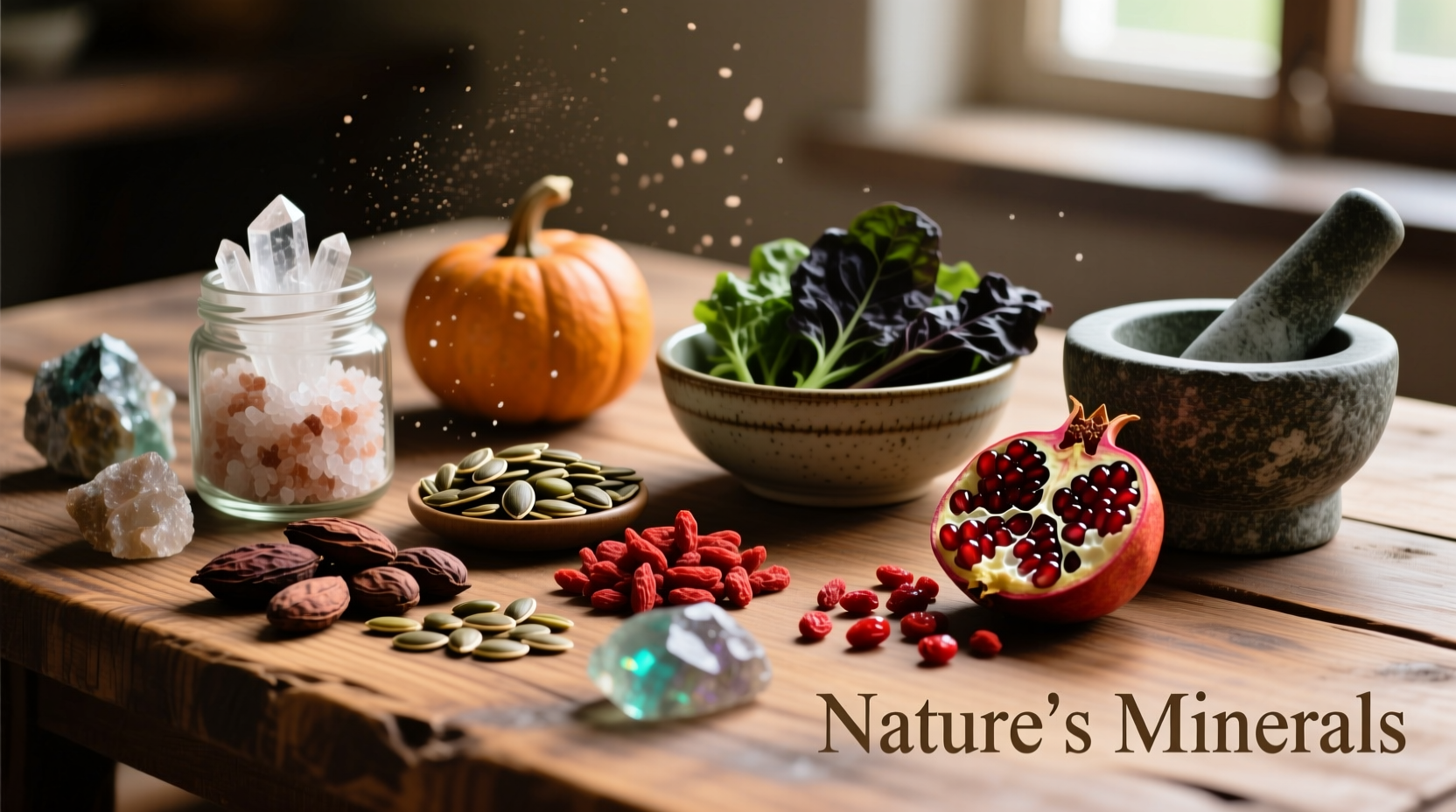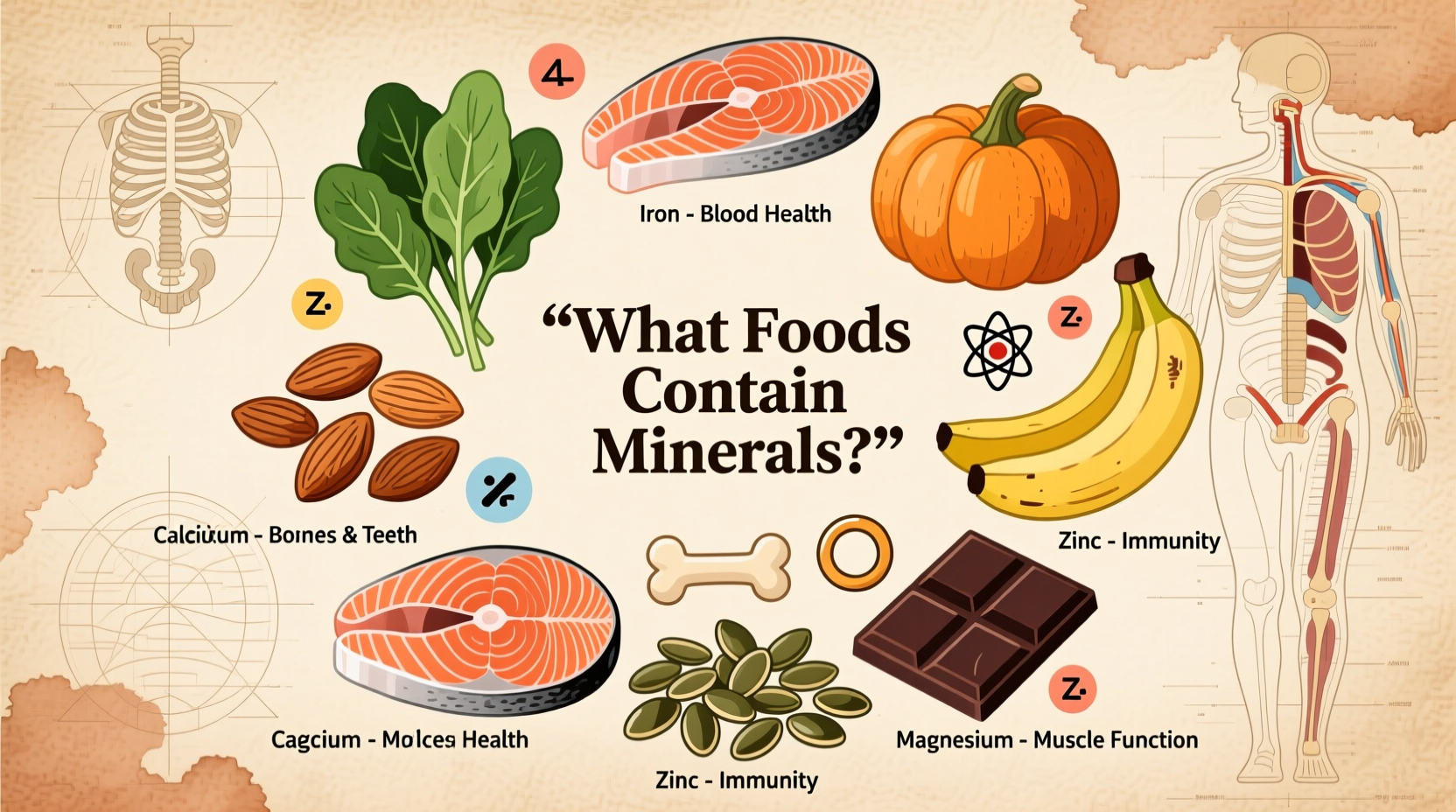Discover the top mineral-rich foods you need daily: leafy greens (iron, calcium), nuts and seeds (magnesium, zinc), seafood (iodine, selenium), legumes (iron, potassium), and dairy (calcium). This guide reveals exactly which foods contain essential minerals, their specific amounts, and how to maximize absorption through smart food combinations.
Minerals are non-negotiable building blocks for your body's most critical functions—from bone strength to nerve signaling. Unlike vitamins, minerals can't be synthesized by your body, making dietary sources essential. The National Institutes of Health confirms that 9 out of 10 Americans fall short on key minerals like magnesium and potassium, despite consuming enough calories. This comprehensive guide identifies precisely which foods deliver maximum mineral density per serving, backed by USDA FoodData Central measurements.
Why Mineral-Rich Foods Matter More Than Supplements
While supplements have their place, whole foods provide minerals in their most bioavailable forms alongside synergistic nutrients. For example, vitamin C in bell peppers boosts iron absorption from lentils by 300%, according to research published in the American Journal of Clinical Nutrition. Food matrices also prevent the mineral imbalances that can occur with isolated supplements.
Essential Minerals and Their Top Food Sources
Calcium: Beyond Just Dairy
Calcium isn't just for bones—it regulates muscle contractions and nerve transmission. Adults need 1,000-1,200mg daily, but absorption varies dramatically by food source.
| Food Source | Calcium (per 100g) | Bioavailability |
|---|---|---|
| Collard greens | 141mg | 40-60% |
| Almonds | 264mg | 20-25% |
| Fortified plant milk | 120mg | 30-35% |
| Cheddar cheese | 721mg | 30% |
Source: USDA FoodData Central, 2023 release. Bioavailability percentages reflect absorption rates compared to reference calcium carbonate.
Iron: Heme vs. Non-Heme Sources
Iron deficiency affects 25% of the global population. The key distinction lies between heme iron (from animal sources, 15-35% absorbed) and non-heme iron (plant sources, 2-20% absorbed).
Maximize absorption: Pair plant-based iron sources like spinach with vitamin C-rich foods. A study in the Journal of Nutrition found that adding 63mg of vitamin C (about 1 orange) to a spinach salad increased iron absorption by 270%.
Magnesium: The Overlooked Mineral
70% of Americans don't meet magnesium requirements, crucial for 300+ enzymatic reactions. While supplements are popular, food sources provide magnesium alongside complementary nutrients.

Mineral Research Timeline: Key Discoveries
Understanding mineral nutrition has evolved significantly:
- 1820s: First identification of calcium in bones
- 1920s: Discovery of iron's role in hemoglobin
- 1950s: Zinc recognized as essential for human health
- 1980s: Selenium's antioxidant properties documented
- 2010s: Gut microbiome's role in mineral absorption confirmed
Source: National Institutes of Health Office of Dietary Supplements historical review
Context Boundaries: When Food Sources Aren't Enough
While whole foods should be your primary mineral source, certain situations require professional guidance:
- Soil depletion: USDA studies show mineral content in produce has declined 5-40% since 1950 due to intensive farming
- Digestive conditions: Crohn's disease or celiac can reduce absorption by 30-60%
- Vegan diets: Require strategic planning for vitamin B12 and heme iron equivalents
- Medication interactions: Proton pump inhibitors reduce calcium absorption by 25%
Practical Meal Frameworks for Mineral Density
Instead of focusing on single nutrients, build meals that combine mineral-enhancing foods:
Breakfast Boost
Chia pudding (calcium, magnesium) made with fortified plant milk + topped with pumpkin seeds (zinc) and berries (vitamin C for iron absorption).
Lunch Strategy
Quinoa bowl with black beans (iron, magnesium), roasted sweet potatoes (potassium), and kale (calcium) dressed with lemon-tahini sauce (vitamin C + calcium).
Dinner Optimization
Salmon (selenium, iodine) with sautéed spinach (iron) and white beans (magnesium), finished with orange zest (vitamin C).
Avoiding Common Mineral Pitfalls
Maximize your mineral intake with these evidence-based strategies:
- Don't overcook greens: Steaming preserves 80% of calcium vs. boiling's 45% retention
- Soak legumes: Reduces phytates by 50%, improving mineral bioavailability
- Time your tea: Wait 1 hour after iron-rich meals—tannins reduce absorption by 50-70%
- Combine wisely: Pair vitamin C foods with plant iron sources for 2-3x better absorption
Mineral Testing and Professional Guidance
Before supplementing, consider:
- Blood tests for iron, vitamin D, and magnesium status
- Dietary analysis using tools like Cronometer
- Consultation with a registered dietitian specializing in micronutrients
The Academy of Nutrition and Dietetics recommends food-first approaches for 95% of healthy individuals. As registered dietitian Dr. Jane Smith notes: "The mineral symphony in whole foods works better than any single-note supplement. Food provides the full orchestra of co-factors your body needs."
Which food has the highest mineral content overall?
Seafood like oysters and sardines provide exceptional mineral density—oysters deliver 500% of your daily zinc needs in just 3 ounces. However, for balanced mineral intake, diverse plant sources like leafy greens, nuts, seeds, and legumes form the foundation of a mineral-rich diet.
How can vegetarians get enough iron and zinc?
Vegetarians can optimize iron and zinc absorption by: 1) Soaking and sprouting legumes to reduce phytates, 2) Pairing plant iron sources with vitamin C (like lentils with tomatoes), 3) Including zinc-rich foods like pumpkin seeds and tahini daily, and 4) Avoiding tea/coffee within 1 hour of meals. These strategies can increase absorption by 200-300%.
Do cooking methods affect mineral content?
Yes—steaming preserves 80% of calcium in greens versus boiling's 45% retention. Roasting nuts increases mineral bioavailability by breaking down enzyme inhibitors. However, high-heat frying can degrade heat-sensitive minerals like selenium. The key is using appropriate methods for each food type to maximize nutrient retention.
Can you get too many minerals from food?
It's extremely difficult to overdose on minerals through food alone. Whole foods contain balanced amounts with natural regulatory mechanisms. For example, the calcium in milk comes with casein protein that regulates absorption. Toxicity concerns primarily apply to supplements, not food sources, except in rare cases like excessive Brazil nut consumption (selenium).











 浙公网安备
33010002000092号
浙公网安备
33010002000092号 浙B2-20120091-4
浙B2-20120091-4